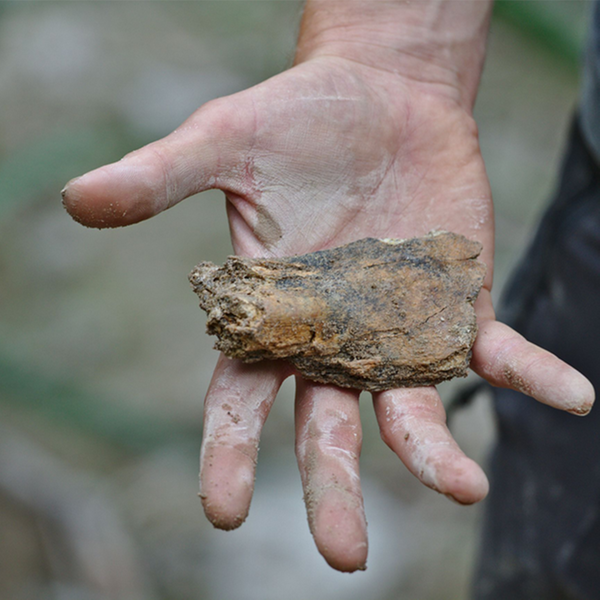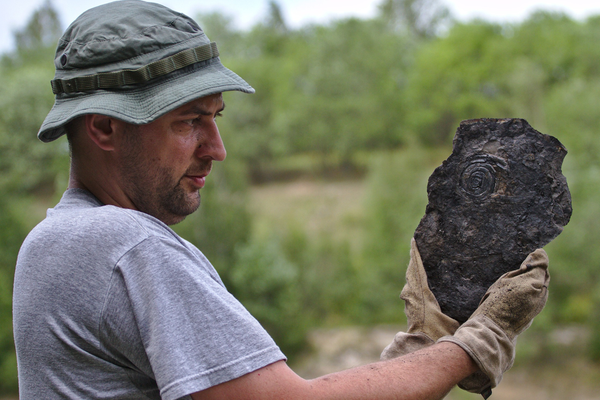Large predatory dinosaurs discovered in Skåne

Part of a jaw from one of the dinosaurs found in Norra Albert. The discovery is just over 200 million years old. Photograph: Grzegorz Niedzwiedzki
Roughly 200-million-year-old footprints of large predatory dinosaurs, along with the skeletons of other dinosaurs, animals and plant fossils, have been discovered in the Norra Albert clay pit in northern Skåne. The discoveries surprised the researchers, as they show that carnivorous dinosaurs of this size existed much earlier than previously known.
“At first, I thought this is too old for such a large footprint, there must be something wrong with the dating. The footprint is 203 million years old, from the Late Triassic period. So I thought, ‘wow, this animal is the same size as an Allosaurus and that’s a little too early for such a big dinosaur,’” explains Grzegorz Niedzwiedzki, Researcher at the Department of Organismal Biology and excavation leader.
But more and more footprints, skeletal parts, plants and even fossilized faeces were unearthed, all of the same age – that is, from the end of the Triassic geological period, or more precisely the very end of the Triassic, just before that period transitioned into the subsequent Jurassic period. This was unexpected, as all previous discoveries around the globe had shown that the dinosaurs of this period were relatively small. However, the predatory dinosaurs from Skåne are some of the oldest found so far and thus point to something completely different.
“We don't have any complete skeletons, but we do have lots of very well-preserved bones and at least three new species of dinosaur that are so far unknown to science. 90 percent of the collected bone material probably belongs to an individual that was a fairly large predatory dinosaur. But we also have some other bones from what I believe is a very large predatory dinosaur, as we also have a set of large teeth,” adds Niedzwiedzki.
Among the things found in Norra Albert are herbivorous dinosaurs, fossils and remains from many other animals and plants of the period. All of the discoveries collected have been taken to the Museum of Evolution in Uppsala, where the researchers will now study them for many years.
.png)
Some of the footprints are close to 80 centimetreslong. Photo: Grzegorz Niedzwiedzki
“The transition period is a very interesting point in the evolution of ecosystems on land, from the Triassic, where we still have some ancient land-dwelling lifeforms, to the Jurassic, which is completely dominated by dinosaurs. There is a big question mark as to why we see this drastic change. In Skåne, we have a truly unique opportunity to find answers to some of these questions that are connected to how the dinosaurs' world domination came about. Following the Triassic and Early Jurassic periods, 90 percent of all animals in the land-based systems were dinosaurs,” continues Niedzwiedzki.
Since the researchers found so many fossils from many different kinds of organisms in Norra Albert, they will be able to recreate the habitat of that period. They will also be able to compare the discoveries to those of other places on Earth to try to understand this period better. It is already clear, however, that the discoveries in Skåne are of great scientific value.
“It’s important to do large-scale excavations, because despite the few years of hard work involved, the results are spectacular. We have something completely unique: large collections of fossils from one locality. There are lots of plant fossils, of course, but also dinosaur fossils. It is still possible to do this kind of exploration even here in Sweden. There will be more to come,” adds Niedzwiedzki.

Large amounts of bones have been found, but nocomplete skeletons. Photo: Grzegorz Niedzwiedzki

Grzegorz Niedzwiedzki, Researcher at the Department of Organismal Biology, led the excavations. He is shown here studying a plant fossil.

There are many footprints left by three-toeddinosaurs. Photo: Grzegorz Niedzwiedzki
Åsa Malmberg
